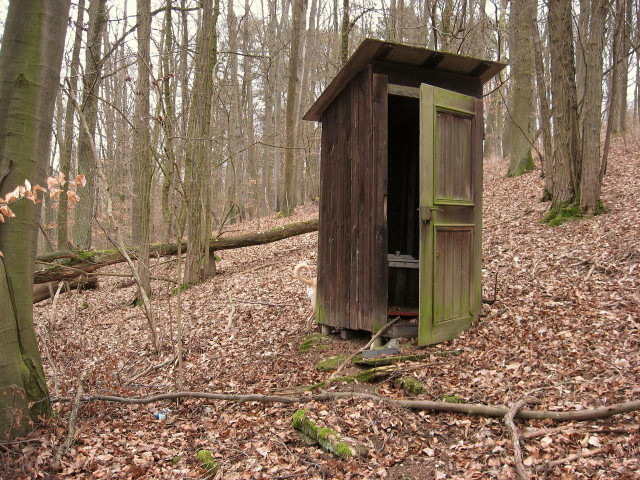Compost toilets are dry toilets that turn human waste into compost and minimize water use. We'll take a look at the different types of compost toilets available and how they work.
So what are compost toilets? The answer can sometimes be broad and confusing.
Composting toilets may be simple, homemade toilets or expensive store-bought ones, and anywhere in between. The idea behind composting toilets is that they deal with human waste naturally and sustainably via decomposition and evaporation.
They use wood shavings, bark mulch, coconut coir and leaves to allow natural bacteria to break down waste through aerobic decomposition. You can make homemade composting toilets relatively inexpensively, too.
Composting toilets are either split systems or self-contained and can be portable or built-in. The most basic is the single composting toilet, where waste goes in the top and is removed from the bottom. This type can be homemade and is ideal for off-grid as it requires no electricity and very little water.
How Do Composting Toilets Work?

(Foto: Aisha Williams)
Whether DIY or store-bought, it’s a good idea to understand how compost toilets work before using or buying one. First commercialized in Sweden over 40 years ago, they decompose human waste into compost (also known as humus) through an aerobic decomposition process.
Basic composting toilets combine waste with wood chips and proper airflow, which allows the waste to be broken down by natural bacteria. They have a chamber and an access point to remove the compost (humus). They don’t require much water and need no electricity; furthermore, evaporation limits odor naturally. The result is compost you can dispose of in many ways.
Some more advanced composting toilets use a similar concept but offer a more complex ventilation system. The compost must still be removed, but how often depends on usage.
Ventilation is an essential element of composting toilets. Some use a fan to aid ventilation, while others build the structure itself to promote adequate airflow.
Getting Rid of Humus



(Foto: CC0 / Pixabay / cocoparisienne)
According to the US Environmental Protection Agency, if you have a garden, you can bury compost as long as it is not in an edible food-growing area. For example, it should not be around growing fruit or vegetables, but it is safe around trees or shrubs as long as it is a reasonable distance from homes. These regulations exist because the waste from composting toilets may contain harmful bacteria.
Regarding composting toilets in towns or villages, methods used to dispose of compost from human waste can vary, as states have different regulations. The US Department of Agriculture states disposal of composted materials depends on your location, regional, local or national policy, and state requirements. If you have a composting toilet and live in a town, there may be nearby facilities where you can drop off the waste. As with all good hygiene standards, care must be taken when dealing with waste compost due to the potential risk of contamination.
Where Are Compost Toilets Used?



(Foto: CC0 / Pixabay / MikeGoad)
Composting toilets can be used off-grid or in your home. The latter requires planning, attention to safety, and knowledge of local regulations depending on where you live. Both types of composting toilets are more economical and eco-friendly than regular flushable toilets. A wide range of options are available, so do your research and check local regulations to find what works best for you. That said, where are compost toilets used?
- Off-grid: In parks, gardens and campsites. Compost toilets used off-grid can be portable (for camping or van life) or static (at camping sites or in parks).
- In-house: These compost toilets are used as an alternative to flushable toilets connected to sewage works. They may have electricity supplies for fans to speed up the decomposition.
Who Are Compostable Toilets for?



(Foto: CC0 / Pixabay / chulmin1700)
Now that we’ve covered the question of what compost toilets are let’s move on to who might want to use them.
Anyone can use composting toilets, and they are currently in many parks in the US and worldwide. Installing a composting toilet in your home allows you to save money on water usage and help the environment.
Composting toilets can be used off-grid, in parks and in more traditional homes. They are economical, require no electricity or water (sometimes just a few ounces) and are eco-friendly, making them an ideal solution for camping, hiking and road trips. They also come in many shapes, colors and styles and can be basic or advanced depending on your preferences and what you can afford.
While composting toilets need to be cleaned out regularly, how often depends on how many people use them. It is vital to keep them properly maintained, so remember to check for leaks or odor regularly. On average, a toilet used by two people should be emptied every two to three months.
Tips and Takeaways



(Foto: CC0 / Pixabay / 2211438)
Composting toilets are extremely eco-efficient and economical. They come in a variety of mobile and static designs and vary in price depending on your budget. While they do not flush like regular toilets, they can be easily cleaned and emptied as long as they are well maintained. However, this idea may not appeal to everyone, as the disposal process can be unpleasant if you are squeamish.
If you like the idea of using or installing a composting toilet, remember to:
- Do your research and check out what types are available and what will suit your needs.
- Check local regulations for toilet installation and disposal of waste procedures.
- Decide where and how you want to use it.
- Consider your budget.
- If you know someone who has a composting toilet, ask them for advice.
Read more:
- 10 Essential Tips for Camping as a Family
- How Does Composting Work? A Step-By-Step Guide
- Modern Homesteading: A Guide to Homestead Living
Do you like this post?







